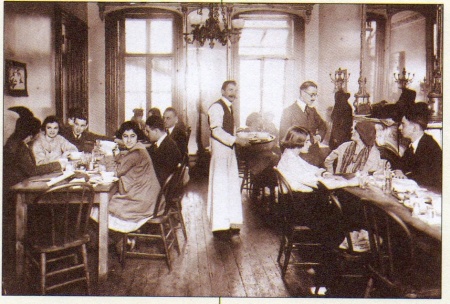 |
| Polly's (1915) |
Location: 137 MacDougal Street, New York, New York, USA from 1913 to 1915; then at 147 West 4th Street from 1915 to 1917
Opened:1913
Closed: 1917
I first found out about Polly's in a brief history/timeline of New York's gay bars. It was published in New York Magazine back in January 2013.
1912-1919: Members of Heterodoxy, a feminist club “for unorthodox women,” meet regularly at Polly’s (137 MacDougal St.), a restaurant run by anarchist Polly Holladay. It becomes a hangout for notable lesbians, including Katherine Susan Anthony and Elizabeth Irwin.
Fortunately, Ephemeral New York tells us more about Polly's, though they don't really discuss the lesbian or feminist connection except in passing.
Polly’s MacDougal Street hangout
Looks like a jolly crowd inside Polly’s restaurant, at 137 MacDougal Street, around 1915. Polly Holladay was an anarchist who opened her eatery when Greenwich Village hit its bohemian heights in the teens.
The place was an instant hit. The artistically minded and politically active—such as Theodore Dreiser, Sherwood Anderson, and Emma Goldman—were regulars. Polly’s moved around the block in 1919, closing for good not long after, about the time when the Village’s bohemian rep made it a favorite for tourists.
The building that housed Polly’s has attracted a lot of attention lately. New York University, which owns 133-139 MacDougal, wants to demolish most of it and put a new structure inside the old facade.
That’s not sitting well with local activists, who note that such a historic building—it formed the epicenter of an artistic movement that included Eugene O’Neill’s Provincetown Playhouse, the Liberal Club, and the Heterodoxy Club (a feminist group)—should be preserved.
Notice that this Greenwich Village walking tour guide also mentions the former Polly's, but says nothing about any women there other than the owner. Unfortunately, I find this is true of a lot of walking tours--the history of women as it interwines with a particular place is typically ignored.
Notice that this Greenwich Village walking tour guide also mentions the former Polly's, but says nothing about any women there other than the owner. Unfortunately, I find this is true of a lot of walking tours--the history of women as it interwines with a particular place is typically ignored.
The Heterodoxy Club
One example of this new feminism was the Heterodoxy Club of Greenwich Village, a group of 25 women coming together in 1912. The club met at regular Saturday meetings, and was a consciousness-raising group before term was invented. The members of the club were inward-looking and individualistic despite their ideology of women's social awakening and concern with social tumult around them. Their purpose was individual psychic freedom. Said Marie Jenny Howe, leader of Heterodoxy Club and a middle-aged nonpracticing minister and wife of noted Progressive municipal reformer Frederic Howe, "We intend simply to be ourselves, not just our little female selves, but our whole big human selves." Feminism stood for self-development as contrasted with self-sacrifice or submergence in family. The feminists of Heterodoxy Club were all highly educated women, with either formal education in colleges and graduate school or informal education in labor or socialist movements. They were able to assert individuality in livelihood, personal relationships, habits of dress and living.
No comments:
Post a Comment
Note: Only a member of this blog may post a comment.